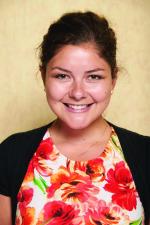The Medical Physicist
Fall
2017
Spotlight on Hidden Physicists
The Medical Physicist
Melissa Lamberto, Medical Physicist at the Department of Radiation Oncology at PinnacleHealth’s Cancer Center Sigma Pi Sigma University of the Sciences Chapter ‘17
 Do you want a great conversation starter? Become a medical physicist! Most people I meet ask me the same follow-up question, “You’re a what?!” I think it’s one of the perks of my title because I get to be the first person to teach them what a medical physicist does! As a medical physicist, I solve new and interesting problems every day. My role in the department is to monitor the safety and efficiency of radiation treatments for our cancer patients. I use my physics background to monitor and calibrate our radiation equipment, implement new technology, and find solutions to technical issues with our systems.
Do you want a great conversation starter? Become a medical physicist! Most people I meet ask me the same follow-up question, “You’re a what?!” I think it’s one of the perks of my title because I get to be the first person to teach them what a medical physicist does! As a medical physicist, I solve new and interesting problems every day. My role in the department is to monitor the safety and efficiency of radiation treatments for our cancer patients. I use my physics background to monitor and calibrate our radiation equipment, implement new technology, and find solutions to technical issues with our systems.
Every patient is unique, so our goal is to come up with the best individualized plan to shrink the tumor, prevent future disease spread, and/or relieve the patient’s pain. To get the job done, we work as a cancer care team—the radiation oncologist who prescribes the treatment, the radiation oncology nurse who manages the patient’s day-to-day care, the dosimetrist who creates the treatment plan, the radiation therapist who positions the patient for their daily radiotherapy treatment, and, of course, the medical physicist. My role in the group is to provide quality assurance throughout the process. On top of that I work with equipment vendors, engineers, IT specialists, state regulators, and even housekeeping! Coordinating with all of these people is often challenging, but my role as a physicist is to ensure the patient’s safety is preserved. I need to make sure that all of the important information is relayed to everyone involved in our patients’ care.
On top of working with a variety of people, I get to work with a wide range of equipment. We use cutting-edge technology to deliver treatment in different ways. For example, we can treat the patient with radiation externally from a linear accelerator, or internally with brachytherapy. I need to be an expert in each of these special techniques so I can detect anything from a minor malfunction to a major error. This can be a challenge, especially when multiple problems come up at once. One thing I’ve learned through my work experience is that it is okay to not always know what to do right away! Sometimes I have to do my research and find alternative solutions with the resources I have available.
Ultimately, though, I get to use physics fundamentals to directly help people stand up to cancer. This is the most rewarding feeling, because I know I am doing something that makes a difference during the most difficult time of a person’s life.
____________________
Share Your Hidden Physicist Story
One of Sigma Pi Sigma’s greatest assets is its diversity. Stemming from a common interest in and aptitude for physics, our members have gone on to pursue a multitude of interesting and unusual career paths. Now, more than ever, we seek to draw on the wisdom and experience of our alumni.
If you work outside the traditional physics community, please share your story at www.sigmapisigma.org/hidden.
Responses will be selected for publication in each issue of Radiations magazine.
